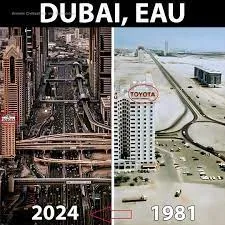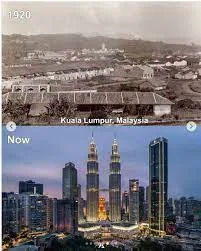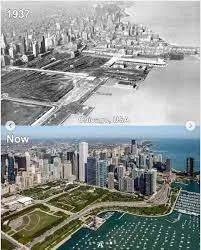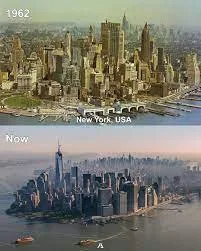The Urban Evolution: Global Cities Transformed Since the 1960s
Since the early 1960s, cities like Abu Dhabi, Dubai, New York, Seoul, Kuala Lumpur, Chicago, London, and Tokyo have undergone dramatic transformations, evolving from modest origins or established hubs into global metropolises. These urban centers have redefined their skylines with iconic architecture, blending innovation, cultural heritage, and economic ambition. Each city’s journey reflects unique historical, technological, and social shifts, creating a mosaic of modern urbanism.
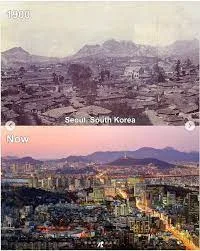
Chicago: The Rise of the Willis Tower
Chicago, already a hub of architectural innovation by the 1960s, cemented its reputation with the construction of the Willis Tower (originally Sears Tower) from 1970 to 1973. Standing at 442 meters (1,450 feet), it held the title of the world’s tallest building for 25 years. Designed by Skidmore, Owings & Merrill, its bundled-tube structural system revolutionized skyscraper design, enabling unprecedented height and stability. Chicago’s blend of historic landmarks like the Wrigley Building and modern giants like the Willis Tower showcases its enduring role as an architectural pioneer.
London: Balancing Heritage and Modernity
London’s transformation since the 1960s has been a delicate dance between preserving its historic charm and embracing modern ambition. The city introduced sleek skyscrapers like the Shard (completed 2012, 310 meters), Western Europe’s tallest building, while maintaining iconic landmarks such as St. Paul’s Cathedral. The 1960s saw the rise of projects like the Centre Point tower, sparking debates over modernist architecture in a city of Georgian and Victorian heritage. London’s skyline reflects a careful integration of old and new, with buildings like the Walkie Talkie and Gherkin adding bold, contemporary flair.
Kuala Lumpur: From Colonial Roots to Global Heights
Kuala Lumpur, once a small colonial tin-mining settlement, transformed into a vibrant metropolis by the late 20th century. The Petronas Towers, completed in 1998, became its crowning achievement. At 452 meters (1,483 feet), these twin towers, designed by César Pelli, held the title of the world’s tallest buildings until 2004. Their postmodern design, with Islamic architectural motifs, reflects Malaysia’s cultural identity and economic ascent. Kuala Lumpur’s rapid urbanization, fueled by economic growth and government investment, turned it into a global financial hub.
Abu Dhabi and Dubai: Desert to Dazzling Hubs
In the early 1960s, Abu Dhabi and Dubai were modest desert towns reliant on fishing and trade. The discovery of oil catalyzed their transformation into international powerhouses. Dubai’s Burj Khalifa, completed in 2010 and soaring to 829.8 meters (2,722 feet), remains the world’s tallest structure, symbolizing the city’s audacious ambition. Abu Dhabi, meanwhile, developed cultural landmarks like the Sheikh Zayed Grand Mosque, blending tradition with modernity. Both cities leveraged wealth and vision to create futuristic skylines, with Dubai’s Burj Al Arab and Abu Dhabi’s Capital Gate showcasing architectural daring.
Seoul: Technology and Towering Ambition
Seoul’s transformation since the 1960s mirrors South Korea’s rapid economic rise. From a city rebuilding after the Korean War, it became a global tech and cultural hub. The Lotte World Tower, completed in 2017 and standing at 555 meters (1,821 feet), is South Korea’s tallest building and a symbol of its technological prowess. Seoul’s skyline, dotted with sleek skyscrapers and innovative designs, reflects its embrace of cutting-edge urban planning and infrastructure, while cultural districts like Gangnam highlight its dynamic pop culture influence.
Tokyo: A Futuristic Metropolis
Tokyo, already a major city in the 1960s, evolved into a dense, futuristic urban landscape. Post-World War II reconstruction and economic growth spurred developments like the Tokyo Skytree (634 meters, completed 2012), the world’s tallest tower. Tokyo’s skyline blends ultramodern structures with traditional elements, such as temples nestled among skyscrapers. Its efficient urban systems, from high-speed rail to vertical gardens, exemplify innovation in a city constrained by space but driven by ambition.
A Global Tapestry of Transformation
These cities, each with distinct histories and cultures, share a common thread: the drive to redefine themselves through architecture and urban development. From Chicago’s pioneering skyscrapers to Dubai’s record-breaking towers, the post-1960s era has seen cities use bold designs to assert their place on the global stage. Like ancient monuments such as the Dolmen de Bagneux or the White Horse of Uffington, these modern structures mark territory and identity, but on a scale unimaginable to Neolithic builders. They stand as testaments to human ingenuity, ambition, and the ever-evolving story of urban life.
